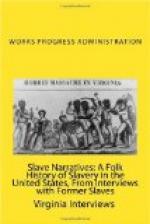“Lordy Mussy, Miss! I had a time jinin’ up wid de church. I was in Mailpack, New York, wid Miss Ruth when I had de urge to jine up. I told Miss Ruth ’bout it and she said: ’Dere ain’t no Baptist church in 10 miles of here.’ ‘Lord, have mussy!’ I said. ’Miss Ruth, what I gwine do? Dese is all Methodist churches up here and I jus’ can’t jine up wid no Methodists.’ ‘Yes you can,’ she snapped at me, ’cause my own Pa’s a-holdin a ’vival in dis very town and de Methodist church is de best anyhow.’ Well, I went on and jined de Reverend Lincoln’s Methodist church, but I never felt right ’bout it. Den us went to Philadelphia and soon as I could find a Baptist church dar, I jined up wid it. Northern churches ain’t lak our southern churches ’cause de black and white folkses all belong to de same church dar and goes to church together. On dat account I still didn’t feel lak I had jined de church. Bless your sweet life, Honey, when I come back to de South, I was quick as I could be to jine up wid a good old southern Baptist church. I sho didn’t mean to live outdoors, ’specially atter I dies.” Georgia’s eyes sparkled and her flow of speech was smooth as she told of her religious experiences. When that subject was exhausted her eyes dimmed again and her speech became less articulate.
Georgia’s reeking pipe had been laid aside for the watermelon and not long after that was consumed the restless black fingers sought occupation sewing gay pieces for a quilt. “Miss, I warn’t born to be lazy, I warn’t raised dat way, and I sho ain’t skeered to die.
“Good-bye, Honey,” said Georgia, as the interviewer arose and made her way toward the street. “Hurry back and don’t forgit to fetch me dat purty pink dress you is a-wearin’. I don’t lak white dresses and I ain’t never gwine to wear a black one nohow.”
[TR: Return Visit]
Georgia was on the back porch washing her face and hands and quarrelling with Ida for not having her breakfast ready at nine-thirty when the interviewer arrived for a re-visit.
“Come in,” Georgia invited, “and have a cheer. But, Miss I done told you all I knows ’bout Marse Alec and dem deys when I lived on his plantation. You know chillun den warn’t ’lowed to hang ’round de grown folks whar dey could hear things what was talked about.”
About this time Ida came down from a second-floor kitchen with her mother’s breakfast. She was grumbling a little louder on each step of the rickety stairway. “Lord, have mussy! Ma is still a-talkin’ ’bout dat old slavery stuff, and it ain’t nothin’ nohow.” After Ida’s eyes had rested on the yellow crepe frock just presented Georgia in appreciation of the three hours she had given for the first interview, she became reconciled for the story to be resumed, and even offered her assistance in rousing the recollections of her parent.
“Did I tell you” Georgia began, “dat de man what looked atter Marse Alec’s business was his fust cousin? He was de Marse Lordnorth I’se all time talkin’ ’bout, and Marse John was Marse Lordnorth’s brother. Dere warn’t no cook or house gal up at de big house but Ma ’til atter she died, and den when Miss Mary Berry tuk charge of de house dey made Uncle Harry and his wife, Aunt ’Liza, house boy and cook.




